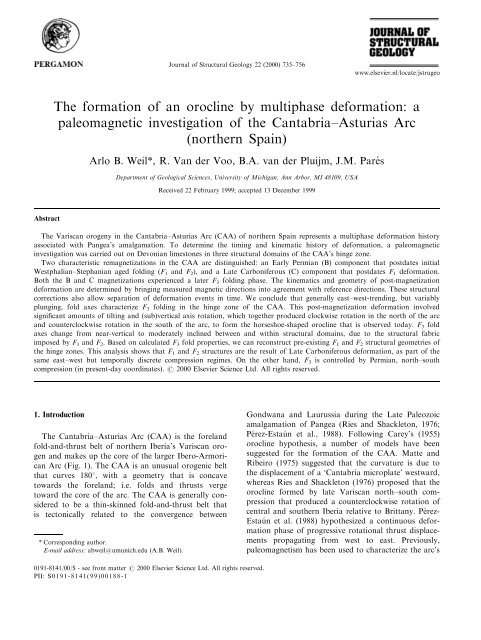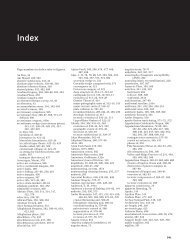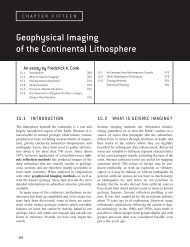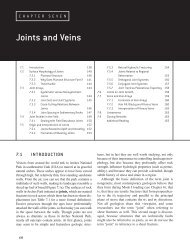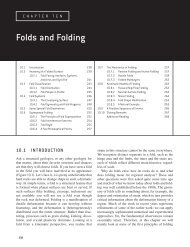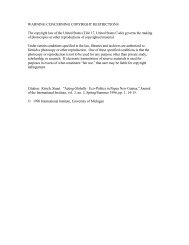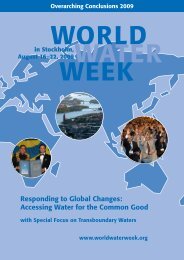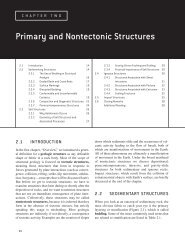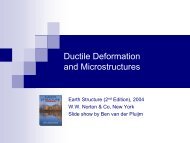The formation of an orocline by multiphase ... - ResearchGate
The formation of an orocline by multiphase ... - ResearchGate
The formation of an orocline by multiphase ... - ResearchGate
You also want an ePaper? Increase the reach of your titles
YUMPU automatically turns print PDFs into web optimized ePapers that Google loves.
738A.B. Weil et al. / Journal <strong>of</strong> Structural Geology 22 (2000) 735±756de<strong>formation</strong>, the Varisc<strong>an</strong> orogeny, which caused theC<strong>an</strong>tabria region <strong>of</strong> northern Spain to undergo forel<strong>an</strong>dstyle de<strong>formation</strong> <strong>an</strong>d develop ultimately into thecore <strong>of</strong> Western Europe's Ibero-Armoric<strong>an</strong> Arc(Matte, 1991; Bachtadse <strong>an</strong>d V<strong>an</strong> der Voo, 1986).Reviews <strong>of</strong> the stratigraphy, lithology, basin history,<strong>an</strong>d general structural <strong>an</strong>d tectonic history <strong>of</strong> theregion c<strong>an</strong> be found elsewhere (e.g. Julivert, 1971; Julivert<strong>an</strong>d Marcos, 1973; Reijers, 1980, 1985; Pe rez-Estau n et al., 1988).2.1. Structural domains sampled for this study<strong>The</strong> S<strong>an</strong>ta Lucia <strong>an</strong>d Portilla <strong>formation</strong>s weresampled in three structural domains: the La Queta <strong>an</strong>dLa Vega de los Viejos Synclines, <strong>an</strong>d the ProzaAnticline. <strong>The</strong> La Queta <strong>an</strong>d La Vega de los Viejosdomains are splays in the larger Somiedo-Correcillathrust unit (Fig. 1). <strong>The</strong> Proza domain is part <strong>of</strong> theLa Sobia thrust unit, which is more internal to the arc(Fig. 1). <strong>The</strong>se two units are considered the most signi®c<strong>an</strong>tallochthonous thrust sheets in the fold±thrustprovince <strong>of</strong> the CAA (Julivert, 1971).<strong>The</strong> La Queta domain (Fig. 2) contains a doublyplunging, NNW±SSE-trending syncline that has undergonerefolding in both its northern <strong>an</strong>d southernregions. It is positioned in the outer southern bendzone <strong>of</strong> the CAA in <strong>an</strong> en e chelon arr<strong>an</strong>gement withthe Lagos del Valle <strong>an</strong>d La Vega de los Viejos Synclines(Fig. 1; Julivert <strong>an</strong>d Marcos, 1973; see also V<strong>an</strong>der Voo et al., 1997). <strong>The</strong> La Queta Syncline isbounded on its east <strong>an</strong>d west <strong>by</strong> tightly foldedFig. 3. A schematic geologic map <strong>of</strong> the La Vega de los Viejos Syncline with in-situ magnetic declinations depicted as black arrows for high temperaturecomponents <strong>an</strong>d gray for low temperature components. Notice the strong correlation <strong>of</strong> strike <strong>an</strong>d declination, as well as the highlyfaulted southern section.
A.B. Weil et al. / Journal <strong>of</strong> Structural Geology 22 (2000) 735±756 739<strong>an</strong>ticlines with nearly vertical limbs. <strong>The</strong> attitudes <strong>of</strong>both synclinal limbs show a component <strong>of</strong> (sub)verticalaxis rotation in their sinuous outcrop patterns, whichwas attributed <strong>by</strong> Julivert <strong>an</strong>d Marcos (1973) to interference<strong>of</strong> multiple fold generations; a ®rst fold generationwith vertical axial surfaces <strong>an</strong>d horizontal foldaxes, <strong>an</strong>d a second generation with axial surfaces orthogonalto that <strong>of</strong> the ®rst generation.<strong>The</strong> more westerly La Vega de los Viejos Synclinehas a NW±SE axial trend with both limbs showing acomponent <strong>of</strong> (sub)vertical axis rotation similar inmagnitude <strong>an</strong>d direction to the La Queta Syncline(Fig. 3). <strong>The</strong> entire structure is cut <strong>by</strong> a large right-lateraloblique-slip fault, <strong>an</strong>d cut locally <strong>by</strong> bedding-parallelthrusts. <strong>The</strong> southern edge <strong>of</strong> the Viejos Synclineis heavily faulted <strong>by</strong> imbricated thrusts <strong>an</strong>d strike-slipfaults due to its proximity to the more faultedsouthern Correcilla Unit.Directly to the east <strong>of</strong> the Lagos del Valle Syncline(V<strong>an</strong> der Voo et al., 1997) in the central bend zone <strong>of</strong>the CAA lies the Proza Anticline (Fig. 1). <strong>The</strong> ProzaAnticline is <strong>an</strong> overthrust structure that dies out to thenorth into <strong>an</strong> <strong>an</strong>ticline (Fig. 4). Such fault±fold couplets(e.g. Alvarez-Marro n, 1995; Stewart, 1995) aretypically associated with space problems <strong>an</strong>d shorteningin CAA overthrusts, as well as other curved fold<strong>an</strong>d-thrustbelts (Julivert <strong>an</strong>d Arboleya, 1984). C<strong>an</strong>tabri<strong>an</strong>overthrusts, such as the Proza Anticline, <strong>of</strong>tenhave complex internal structures <strong>an</strong>d usually appear inmultiple stacks that produce stratigraphic repetitionFig. 4. A schematic geologic map <strong>of</strong> the Proza Anticline with in-situ magnetic declinations shown as white arrows <strong>an</strong>d site locations in blackstars. Notice the strong correlation <strong>of</strong> strike <strong>an</strong>d declination, especially in the southern bend zone. Reference B magnetization is shown for relativecomparison <strong>of</strong> individual site rotations.
740A.B. Weil et al. / Journal <strong>of</strong> Structural Geology 22 (2000) 735±756<strong>an</strong>d thickening (Bonhommet et al., 1981). <strong>The</strong> schematicgeologic map in Fig. 4 shows the eastern limb <strong>of</strong>the Proza <strong>an</strong>ticline truncated <strong>by</strong> the western limb in responseto <strong>an</strong> eastward propagating thrust. <strong>The</strong> <strong>an</strong>ticlineitself has a small interlimb <strong>an</strong>gle <strong>of</strong> 30±458, <strong>an</strong>d ahinge line that is oblique to the direction <strong>of</strong> thrustmovement (Julivert <strong>an</strong>d Arboleya, 1984). Julivert <strong>an</strong>dArboleya (1984) proposed that the Proza Anticline isthe result <strong>of</strong> thrust emplacement <strong>by</strong> rotational motioncentered at the northern fault terminus. Such a kinematicscenario would require that the thrust sheet beprogressively curved as it was emplaced, rather th<strong>an</strong>moving as a rigid plate. Thus, according to this model,the tightening <strong>of</strong> the structure <strong>an</strong>d its curvature wouldbe contempor<strong>an</strong>eous with thrust emplacement <strong>an</strong>d notthe result <strong>of</strong> multiple de<strong>formation</strong> events. This viewc<strong>an</strong> be tested with detailed paleomagnetic data.3. Sampling <strong>an</strong>d experimental methodsApproximately 500 cores were collected in the summers<strong>of</strong> 1996 <strong>an</strong>d 1997 at 22 sites in the Portilla Formation<strong>an</strong>d 38 sites in the S<strong>an</strong>ta Lucia Formation. Sitelocations were distributed throughout all three structuraldomains <strong>an</strong>d severe outcrop weathering <strong>an</strong>dhighly faulted areas were avoided where possible.Oriented samples were collected in the ®eld using aportable drill <strong>an</strong>d a magnetic compass. Bedding directions<strong>an</strong>d shear-sense indicators were measured in the®eld using a magnetic compass.On average, from seven to ten st<strong>an</strong>dard 2.54-cm-diameterpaleomagnetic specimens from each site wereprogressively demagnetized in <strong>an</strong> Analytical ServiceCo. (ASC) thermal demagnetizer <strong>an</strong>d measured in athree-axes cryogenic 2G magnetometer in the ®eld-freeroom at the University <strong>of</strong> Michig<strong>an</strong>'s paleomagneticlaboratory. Heating was carried out in 508C incrementsto a maximum temperature <strong>of</strong> 5508C, withreduced increments at temperatures above 3508C.Alternating Field (AF) demagnetization was performedwith a Sapphire Instruments SI-4 AF demagnetizer;however, the AF treatment was unable to isolate theprincipal components <strong>of</strong> the rem<strong>an</strong>ence properly. Inthe thermally treated samples, rem<strong>an</strong>ence directionswere calculated from Principal Component Analysis(Kirschvink, 1980) <strong>of</strong> linear demagnetization vectorspicked from paleomagnetic orthogonal projection plots(Zijderveld, 1967). In those cases in which a site hadmore th<strong>an</strong> two magnetization components, the Ho€m<strong>an</strong><strong>an</strong>d Day (1978) great-circle method was used toisolate the rem<strong>an</strong>ence directions.Site me<strong>an</strong>s were calculated <strong>by</strong> averaging the sampleset directions, using the method <strong>of</strong> Fisher (1953). Inclination-only(Pare s et al., 1994) <strong>an</strong>d local fold tests(McElhinny, 1964) were used to characterize the age <strong>of</strong>the magnetization components with respect to foldingin the individual domains. However, because <strong>of</strong> thelocal declination scatter caused <strong>by</strong> (sub)vertical axis rotations,the inclination-only test was predomin<strong>an</strong>tlyused. With this test it is possible to account for thestatistically signi®c<strong>an</strong>t clustering <strong>of</strong> inclinations afterpartial or full tectonic correction, independent <strong>of</strong> thedeclination scatter produced <strong>by</strong> vertical axis rotation(McFadden <strong>an</strong>d Reid, 1982).4. Results<strong>The</strong> S<strong>an</strong>ta Lucia <strong>an</strong>d Portilla limestones have similardemagnetization characteristics <strong>an</strong>d the two <strong>formation</strong>swill be treated together in the following discussion.<strong>The</strong> results from demagnetization for all three structuraldomains are presented in Table 1. Two magnetizationsare distinguished, in addition to the presentday®eld overprint: <strong>an</strong> early Permi<strong>an</strong> (B) component,<strong>an</strong>d a Late Carboniferous (C) component. This ageassignment is the same as that used <strong>by</strong> V<strong>an</strong> der Voo etal. (1997). <strong>The</strong> present-day ®eld A magnetization,which is northerly <strong>an</strong>d down, has a low unblockingtemperature <strong>an</strong>d is removed <strong>by</strong> 2508C. This is followed<strong>by</strong> the intermediate B magnetization, which has ame<strong>an</strong> inclination <strong>of</strong> +1.5823.18 (as calculated <strong>by</strong> V<strong>an</strong>der Voo et al., 1997), <strong>an</strong>d <strong>an</strong> unblocking temperatureup to 4808C. <strong>The</strong> C magnetization has a me<strong>an</strong> inclination<strong>of</strong> +5.0826.68 (as calculated <strong>by</strong> V<strong>an</strong> der Vooet al., 1997), <strong>an</strong>d unblocks at temperatures up to 508C.4.1. Tectonic correctionsDue to the complexity <strong>of</strong> superimposed-folding inthe area, a method was devised to determine the optimaltectonic correction for individual site me<strong>an</strong> directions.Each sampling site was evaluated in the context<strong>of</strong> the local structures to determine the best possiblecorrection to undo post-magnetization tilts <strong>an</strong>d rotations.Within individual structural domains, de<strong>formation</strong>axes were determined <strong>by</strong> calculating the best-®trotation axes to cluster in-situ magnetic vectors. Thisis similar to the approach used <strong>by</strong> Setiabudidaya et al.(1994) <strong>an</strong>d Stewart (1995) to reconstruct complex foldgeometries in comparable structures. <strong>The</strong> observed girdledistributions represent the di€erential rotation <strong>of</strong>F 3 fold limbs in the case <strong>of</strong> the B component, <strong>an</strong>d therotations produced <strong>by</strong> F 2 <strong>an</strong>d F 3 de<strong>formation</strong> for theC component subsequent to magnetization acquisition.By de®nition, the distributions <strong>of</strong> in-situ magnetic vectorsproduced <strong>by</strong> folding will track small-circles thatcontain the original reference magnetic direction (i.e.the me<strong>an</strong> B or C magnetic direction acquired prior t<strong>of</strong>olding). Coincidentally, in most structures studied itwas found that the reference direction was positioned
A.B. Weil et al. / Journal <strong>of</strong> Structural Geology 22 (2000) 735±756 741Table 1Paleomagnetic <strong>an</strong>d structural site in<strong>formation</strong> <strong>an</strong>d statistical parametersSite No. Cores Tectonic Corrections In Situ Site Me<strong>an</strong>Strike Inv. Dip Dip Dir. Dip Dec(Low-Temp)Inc(Low-Temp)alpha 95 K Dec(High-Temp)Inc(High-Temp)alpha 95KLa Queta SynclinePL26 8 318 48 48 142 11 7 108PL27 a 8 170 99 80 81 134 4 6 110PL28 8 145 235 84 123 2 4 284PL29 8 97 187 52 102 43 3 938PL30 a 8 170 95 80 85 111 27 5 170PL31 a 8 137 92 47 88 88 17 10 44PL32 8 300 30 58 140 5 3 437PL33 8 30 120 52 73 53 4 326PL34 8 335 65 55 88 59 5 177PL35 8 275 5 35 141 20 6 187PL36 8 310 40 40 134 1 6 75PL37 8 110 200 38 110 38 6 48PL38 8 191 281 78 143 8 9 48La Vega de los Viejos SynclineSL56 b 6 (108 198 58) (88 22) 9 60 (46 3) 9 61SL57 b 6 (80 170 85) (44 34) 16 19SL58 d 7 112 202 62 125 14 11 27 77 20 9 67SL59 b 7 (166 256 60) (66 42) 10 38SL60 ad 7 (243 135 153 45) (321 52) 14 15 (357 67) 8 66SL61 5 135 225 68 80 41 5 117SL62 6 143 53 90 103 34 3 487SL64 d 8 114 204 50 110 14 9 42 93 13 7 66SL65 8 120 210 84 122 13 9 37SL66 8 164 254 85 126 15 4 167SL67 6 344 74 80 143 2 6 66SL68 6 352 82 80 117 32 13 54SL69 d 9 355 85 77 125 11 6 76 97 20 6 71SL70 6 355 85 70 119 4 5 273SL71 8 354 84 74 140 5 12 21PL49 7 238 328 69 117 47 5 125PL50 5 120 210 51 82 32 10 64PL51 d 8 145 235 78 132 24 9 32 93 27 6 86PL52 ad 8 146 94 56 86 145 39 14 20 114 42 10 33PL53 6 105 195 64 106 6 13 34PL54 a 8 152 99 62 81 129 34 6 70PL55 d 6 125 215 60 120 2 3 626 102 4 8 80PL56 d 5 114 204 41 112 10 5 154 104 14 5 130PL57 8 21 111 55 108 18 10 40Proza AnticlineSL38 8 250 340 54 190 40 6 114SL39 a 8 142 105 52 75 123 16 4 281SL40 c 9 20 110 74 202 12 11SL41w 4 200 290 70 147 3 11 35SL41e 5 360 90 76 129 6 11 29SL42 b 8 358 88 80 (194 41) 6 128 (180 63) 8 48SL43 8 45 135 78 215 24 7 73SL44 9 155 245 39 136 12 5 182SL45 7 238 328 45 175 12 7 71SL46 8 148 238 47 125 15 8 53SL47 8 205 295 47 174 37 8 70SL48 8 216 306 67 168 11 3 704SL72 c 9 218 308 63 186 22 8SL73 6 214 304 62 187 5 8 80SL74 6 221 311 48 177 8 4 246SL75 ab 7 353 102 263 78 (193 27) 6 75SL76 8 45 135 63 225 59 5 294(continued on next page)
742A.B. Weil et al. / Journal <strong>of</strong> Structural Geology 22 (2000) 735±756Table 1 (continued )Site No. Cores Tectonic Corrections In Situ Site Me<strong>an</strong>Strike Inv. Dip Dip Dir. Dip Dec(Low-Temp)Inc(Low-Temp)alpha 95 K Dec(High-Temp)Inc(High-Temp)alpha 95KSL77 b 5 14 104 46SL78 a 9 27 115 297 65 215 34 6 67SL79 a 6 50 100 320 80 220 6 5 220SL80 8 210 300 74 149 50 4 32SL81 6 332 62 70 154 8 4 244SL82 8 113 203 51 106 10 8 131a Designates overturned bedding.b Designates a site that could not be used (explained in text).c Designates a site that required great-circle <strong>an</strong>alysis.d Designates a site that required Ho€m<strong>an</strong> Day (1978) <strong>an</strong>alysis. (Dec, Inc) Represents paleomagnetic data not used in <strong>an</strong>alysis (explained intext).relative to the distributed magnetic vectors, such thatthe Euler pole <strong>of</strong> rotation was approximately 908away. This geometric con®guration resulted in theunique case where the best ®t small-circle is a great-circle.Note that we assume no signi®c<strong>an</strong>t rotation aboutthe axis <strong>of</strong> the (south-southeasterly <strong>an</strong>d shallow) magnetization,which c<strong>an</strong>not be detected <strong>by</strong> this <strong>an</strong>alysis.However, such a rotation would lead to recumbentfolds, which are not observed in our ®eld area orrecognized in the literature. Using the calculated F 3axes, F 3 de<strong>formation</strong> c<strong>an</strong> be removed <strong>an</strong>d the geometry<strong>of</strong> the CAA's hinge zone restored to the time <strong>of</strong>magnetic acquisition. Consequently, this correctionprocess constrains the kinematics <strong>of</strong> F 3 folding, as wellas a reconstruction <strong>of</strong> the CAA's geometry after F 2 de<strong>formation</strong>in the case <strong>of</strong> the B component, <strong>an</strong>d afterF 1 de<strong>formation</strong> in the case <strong>of</strong> the C component.4.2. La Queta SynclineThirteen sites were collected around the La QuetaDomain (Fig. 2). All sites are located in the PortillaFormation, which has continuous exposure around theentire structure. <strong>The</strong> in situ magnetic directions show acorrelation between site me<strong>an</strong> declination <strong>an</strong>d localstrike, <strong>an</strong>d <strong>an</strong> inclination pattern that r<strong>an</strong>ges frommainly upward in the south to steep <strong>an</strong>d downward inthe north (as listed in Table 1). Typical orthogonalprojection plots <strong>an</strong>d site me<strong>an</strong>s for the La Queta Synclineare shown in Figs. 5(a) <strong>an</strong>d 6. After removal <strong>of</strong> aviscous present-day ®eld overprint, one stable <strong>an</strong>cientcomponent was found within the La Queta Domain(Fig. 5a).<strong>The</strong> geometry <strong>of</strong> the La Queta Syncline only permitsfold tests on kilometer-scale folds. A total <strong>of</strong> four foldtests were performed: (1) on the southern tip; (2) onthe northeast corner; (3) on a north-wall interferencefold; <strong>an</strong>d (4) on the entire central zone <strong>of</strong> the mainsynclinal structure. In the southern tip <strong>of</strong> the La QuetaDomain the structure becomes tightened, <strong>an</strong>d thelimbs take on a (sub)parallel orientation. However,because <strong>of</strong> the magnetic declination scatter in thesouthern tip (sites PL26, PL31 <strong>an</strong>d PL32), it is onlypossible to perform <strong>an</strong> inclination test (Fig. 7a). <strong>The</strong>axis <strong>of</strong> the fold trends northwest±southeast <strong>an</strong>d isprobably related to F 1 <strong>an</strong>d F 2 de<strong>formation</strong> because <strong>of</strong>its orientation. At 35% unfolding, the inclinationscluster at +78 with a maximum kappa value <strong>of</strong> 149(Fig. 7a). This result is interpreted as a C componentthat is post-F 1 de<strong>formation</strong> but pre-F 2 <strong>an</strong>d -F 3 de<strong>formation</strong>.Similar fold tests were done on the smaller (sub)parallelfolds found in the northern <strong>an</strong>d northeasternregions <strong>of</strong> the syncline: between sites PL29 <strong>an</strong>d PL33,<strong>an</strong>d sites PL37 <strong>an</strong>d PL38 (Fig. 7b <strong>an</strong>d c). Upon correction(inclination only), sites PL29 <strong>an</strong>d PL33 cluster at35% unfolding with <strong>an</strong> inclination <strong>of</strong> +398(kappa=19,130), <strong>an</strong>d sites PL37 <strong>an</strong>d PL38 cluster at50% unfolding with <strong>an</strong> inclination <strong>of</strong> +358(kappa=10,747). Such high kappa values are caused<strong>by</strong> a high degree <strong>of</strong> clustering combined with a lownumber <strong>of</strong> sites. Both tests are statistically signi®c<strong>an</strong>tat the 95% con®dence level, <strong>an</strong>d are interpreted as a Cmagnetization that predates F 2 <strong>an</strong>d F 3 de<strong>formation</strong>.<strong>The</strong> ®nal fold test was done on the ®ve middle sites(PL27, PL28, PL30, PL35, <strong>an</strong>d PL36), where the insitumagnetic declinations <strong>an</strong>d local strikes are subparallelon both limbs, <strong>an</strong>d the inclinations exhibitconsiderable scatter, r<strong>an</strong>ging from +20 to ±278(Fig. 7d). At 40% unfolding the inclinations clusteredat +138 (kappa=25). <strong>The</strong> results <strong>of</strong> the four fold testsshow a consistent pattern <strong>of</strong> magnetization acquisitionprior to F 2 <strong>an</strong>d F 3 de<strong>formation</strong>. Given the de®nition<strong>of</strong> the C component as post-F 1 <strong>an</strong>d pre-F 2 <strong>an</strong>d -F 3 ,weinterpret the entire La Queta structure as carrying theC magnetization.<strong>The</strong>refore, the C magnetization is used as a rotationconstraint, to ®nd those structural corrections that
A.B. Weil et al. / Journal <strong>of</strong> Structural Geology 22 (2000) 735±756 743bring the in-situ magnetic directions into coincidencewith the reference C magnetization. <strong>The</strong>se structuralcorrections there<strong>by</strong> undo the de<strong>formation</strong> (tilts <strong>an</strong>d rotations)that the rocks have undergone since the acquisition<strong>of</strong> the C-component rem<strong>an</strong>ence (i.e. F 2 <strong>an</strong>d F 3folding). By iterating the possible fold geometries thatwould result in both the La Queta's present-day beddingattitudes <strong>an</strong>d its in-situ magnetic direction scatter,<strong>an</strong> optimum set <strong>of</strong> fold-axes were calculated to correctfor F 2 <strong>an</strong>d F 3 de<strong>formation</strong>.Using the best-®t rotation axis (Fig. 6c <strong>an</strong>d d), tiltcorrectedsite me<strong>an</strong>s <strong>an</strong>d post-rem<strong>an</strong>ence bedding attitudeswere calculated for the northern sites (PL29,PL33, PL34, PL35, PL37, <strong>an</strong>d PL38) <strong>an</strong>d southernsites (PL26, PL27, PL28, PL30, PL31, PL32, <strong>an</strong>dPL36) <strong>of</strong> the La Queta syncline (Fig. 6b). Whenapplied, these corrections create a broad north±southorientedsyncline with intermediately to steeply dippinglimbs, <strong>an</strong>d a slightly northward-plunging fold axis(Fig. 8), there<strong>by</strong> restoring the syncline to its post-F 1geometry (corrected bedding <strong>an</strong>d magnetic directionare listed in Table 2). <strong>The</strong> applied rotations, correcteddeclination, inclinations <strong>an</strong>d bedding are given inTable 2.4.3. La Vega de los Viejos SynclineTwenty-four sites were collected around the LaVega de los Viejos Domain (Fig. 3). Fifteen sitesare located in the S<strong>an</strong>ta Lucia Formation <strong>an</strong>d ninesites are located in the Portilla Formation. Of the24 sites, the four southernmost sites could not beinterpreted (SL56, SL57, SL59 <strong>an</strong>d SL60) due toclearly rotated bedding relative to regional trendscaused <strong>by</strong> complicated local fault rotation (Fig. 3).Both <strong>formation</strong>s have continuous exposure aroundFig. 5. Typical examples <strong>of</strong> orthogonal thermal demagnetization plots (Zijderveld, 1967) in in-situ coordinates from nine Devoni<strong>an</strong> limestonesamples from the Portilla <strong>an</strong>d S<strong>an</strong>ta Lucia <strong>formation</strong>s. Open (closed) symbols represent projections onto the vertical (horizontal) pl<strong>an</strong>e; demagnetizationtemperatures given in degrees Celsius. (a) La Queta Syncline samples. (b) La Vega de los Viejos Syncline samples. (c) Proza Anticlinesamples.
744A.B. Weil et al. / Journal <strong>of</strong> Structural Geology 22 (2000) 735±756the entire structure except for the southwestern corner,which is covered <strong>by</strong> Steph<strong>an</strong>i<strong>an</strong> aged sediments<strong>an</strong>d Quaternary alluvium. Typical orthogonal-projectionplots <strong>an</strong>d site me<strong>an</strong>s for the La Vega de losViejos Syncline are shown in Figs. 5(b) <strong>an</strong>d 9(a)<strong>an</strong>d in-situ site me<strong>an</strong>s are listed in Table 1. Two<strong>an</strong>cient components were observed in all but one <strong>of</strong>the sites. However, in only seven <strong>of</strong> the sites thatcarried both components could stable directions besuciently characterized for paleomagnetic <strong>an</strong>alysisdue to stability spectrum overlapping. To separatethe NRM <strong>of</strong> the low temperature component fromthe high temperature component, we utilized theHo€m<strong>an</strong> <strong>an</strong>d Day (1978) method <strong>of</strong> vector subtraction.<strong>The</strong> site with only one <strong>an</strong>cient component isassumed to carry the high temperature rem<strong>an</strong>ence.<strong>The</strong> in-situ magnetic directions show a correlationbetween site me<strong>an</strong> declination <strong>an</strong>d local strike, <strong>an</strong>d<strong>an</strong> inclination pattern that r<strong>an</strong>ges from mainly steep<strong>an</strong>d upward in the south to steep <strong>an</strong>d downward inthe north, very similar to the La Queta Syncline tothe east (Table 1).<strong>The</strong> outcrop <strong>of</strong> the La Vega de los Viejos Synclineonly permits fold tests on kilometer-scalefolds. A total <strong>of</strong> three fold tests were performed(Fig. 10): (1) on the high temperature components<strong>of</strong> the entire structure except for the southern tip,(2) on the high temperature component <strong>of</strong> sitesPL50 <strong>an</strong>d PL49, <strong>an</strong>d (3) on the low temperaturecomponents <strong>of</strong> two northern sites (SL64 <strong>an</strong>d SL69),one on each limb <strong>of</strong> the syncline.<strong>The</strong> ®rst fold test was <strong>an</strong> inclination-only testdone on the high temperature components <strong>of</strong> sitesFig. 6. La Queta site me<strong>an</strong> stereonet projections for (a) in-situ <strong>an</strong>d(b) structurally corrected magnetic directions. Open symbols representupper hemisphere projections <strong>an</strong>d closed symbols representlower hemisphere projections. (c) Calculated fold axis for the northernLa Queta structure to correct for F 2 <strong>an</strong>d F 3 folding. Circles aresite-me<strong>an</strong>s <strong>an</strong>d diamonds represent best-®t fold axes (lower hemisphere).Gray star represents the reference direction for the C component.(d) Calculated fold-axis for the southern La Queta structureused to correct for F 2 <strong>an</strong>d F 3 folding. Notice the ch<strong>an</strong>ge in fold-axisorientation from south to north to accommodate the complex paleomagneticdirection distribution. Gray star represents the referencedirection for the C component.Fig. 7. Local incremental inclination-only fold tests from the LaQueta Syncline, plotting the kappa parameter (squares) <strong>an</strong>d inclination(diamonds) vs. percent unfolding. (a) A local fold test <strong>of</strong> sitesPL26, PL31, <strong>an</strong>d PL32 showing a C component acquired pre-F 2folding, yielding a 68 inclination at 35% unfolding. (b) A local foldtest <strong>of</strong> sites PL29 <strong>an</strong>d PL33 showing a C component acquired synfoldingwith high (0398) inclination values at 35% unfolding. (c) Alocal fold test <strong>of</strong> sites PL37 <strong>an</strong>d PL38 showing a C componentacquired pre-F 2 with a high inclination value (0358) at 50% unfolding.(d) A local fold test <strong>of</strong> middle sites showing a C componentacquired pre-F 2 with intermediate positive inclination values (0138)at 40% unfolding.
A.B. Weil et al. / Journal <strong>of</strong> Structural Geology 22 (2000) 735±756 745PL51, PL52, PL53, PL54, PL55, PL56, PL57, SL61,SL62, SL64, SL65, SL66, SL67, SL68, SL69, SL70,<strong>an</strong>d SL71 (Fig. 10a). <strong>The</strong> in-situ magnetic declinationsr<strong>an</strong>ge from easterly on the eastern limb tosoutheasterly on the western limb, with local strikehaving approximately 408 <strong>of</strong> curvature on the easternlimb. <strong>The</strong> inclinations between the 17 sites exhibitconsiderable scatter, r<strong>an</strong>ging from +328 to ±428.At 40% unfolding the inclinations clustered at ±68(kappa=18). This result is consistent with a C magnetizationacquisition that is pre-F 2 de<strong>formation</strong>. Asecond inclination-only fold test was done on the hightemperature components <strong>of</strong> sites PL49 <strong>an</strong>d PL50(Fig. 10b). <strong>The</strong>se two sites de®ne <strong>an</strong> east±west-trendingfold in the southern most section <strong>of</strong> the Viejos structure(Fig. 3). At 55% unfolding the inclinations clusteredat ±138 with a high kappa value, consistent with(C) magnetization acquisition prior to F 2 folding. Bothfold tests produce me<strong>an</strong> inclinations that are slightlydi€erent from the expected reference direction, whichwe attribute to tilting subsequent to magnetization acquisition.<strong>The</strong> third inclination-only fold test was done inthe northern section <strong>of</strong> the Viejos domain on twosites that carry the low temperature component:sites SL69 <strong>an</strong>d SL64 (Fig. 10c). At 0% unfoldingthe inclinations clustered at +138 (kappa=730).Again, the somewhat higher th<strong>an</strong> expected inclinationis attributed to tilting subsequent to magnetizationacquisition. <strong>The</strong> fact that all low temperaturesite me<strong>an</strong>s consistently exhibit less rotation awayfrom the reference direction (Table 1), coupled withthe above post-folding fold test result, suggests thatthe low temperature component found in the ViejosSyncline corresponds to a B magnetization acquiredpost-F 2 folding. Due to the scarcity <strong>of</strong> low temperature(B) components, further fold tests could not be performed.Fig. 8. Schematic 3-D drawing <strong>of</strong> the La Queta Syncline in its presentcon®guration (after Julivert <strong>an</strong>d Marcos, 1973) (a), <strong>an</strong>d correctedto its post-F 1 con®guration according to the calculated foldaxes <strong>of</strong> the north <strong>an</strong>d south La Queta structure (b). Individual beddingwas rotated according to the tilts <strong>an</strong>d rotations indicated <strong>by</strong> thedeviating site-me<strong>an</strong> directions <strong>of</strong> the magnetizations (see Table 2 forrotation parameters). After correction the La Queta synclinebecomes less contorted <strong>an</strong>d takes on a more cylindrical north±southtrend.Fig. 9. La Vega de los Viejos site-me<strong>an</strong> stereonet projections forpoles to bedding <strong>an</strong>d in-situ magnetic directions. Open symbols representupper hemisphere projections <strong>an</strong>d closed symbols representlower hemisphere projections. (a) Stereonet <strong>of</strong> in-situ site me<strong>an</strong>s forthe entire Viejos structural domain. Circles correspond to high-temperaturecomponents (C), <strong>an</strong>d squares correspond to low temperaturecomponents (B). (b) In-situ poles to bedding for the entireViejos structure with fold axis shown as black diamond. Overturnedbeds projected as upper hemisphere poles. (c) B component siteme<strong>an</strong>directions for the northern <strong>an</strong>d southern sections <strong>of</strong> the Viejosdomain with best-®t rotation axes (represented <strong>by</strong> black diamonds).Gray stars represent reference B direction. (d) <strong>The</strong> two-step C componentcorrection for those sites that carry both the B <strong>an</strong>d C magnetizations.<strong>The</strong> left stereonet shows the C components rotated withthe B magnetization leaving F 2 de<strong>formation</strong> to correct for. <strong>The</strong> rightstereonet shows the fully corrected C components after F 2 folding iscorrected for. Rotation parameters are listed in Table 3. (e) Stereographicprojections <strong>of</strong> site me<strong>an</strong>s that only carry the stable C componentfor the northern, middle <strong>an</strong>d southern sections <strong>of</strong> the Viejosdomain with best-®t rotation axes (fold axes represented <strong>by</strong> blackdiamonds). Gray stars represent reference C direction.
746A.B. Weil et al. / Journal <strong>of</strong> Structural Geology 22 (2000) 735±756Table 2Summary <strong>of</strong> structurally corrected site in<strong>formation</strong> aSite Number In Situ Bedding Tectonic Correction Tectonically CorrectedStrike Inv. Dip Dip Fold Axis Trend Fold Axis Plunge Rotation Dec Inc Strike DipLa Queta SynclinePL26 318 48 65 70 10 151 14 330 47PL27 b 170 99 81 65 70 27 159 5 196 94PL28 145 84 65 70 27 148 6 169 84PL29 97 52 242 36 52 144 6 171 38PL30 b 170 95 85 65 70 45 150 13 213 86PL31 b 137 92 88 65 70 75 160 4 217 81PL32 300 58 65 70 27 165 5 331 55PL33 30 52 242 36 75 147 7 306 9PL34 335 55 242 36 75 157 6 335 55PL35 275 35 242 36 17 150 6 276 46PL36 310 40 65 70 20 153 6 337 39PL37 110 38 242 36 44 143 6 187 36PL38 191 78 242 36 2 144 6 192 79La Vega de los Viejos SynclineSL58 112 62 60 30 32 141 12 120 78SL58H c 112 62 67 63 67 148 3 167 72SL61H 135 68 55 45 81 150 8 184 74SL62H 143 90 55 45 61 151 6 183 76SL64 114 50 249 77 34 144 8 154 47SL64H c 114 50 284 81 51 148 12 169 44SL65H 120 84 264 73 30 151 6 150 79SL66H 164 85 55 45 33 150 8 184 74SL67H 344 80 55 45 12 152 6 354 83SL68H 352 80 264 73 30 149 25 19 77SL69 355 77 249 77 34 158 4 27 73SL69H c 355 77 276 81 46 146 17 40 75SL70H 355 70 55 45 30 140 17 20 84SL71H 354 74 55 45 15 151 6 7 80PL49H 238 69 60 51 75 150 7 325 34PL50H 120 51 60 51 35 150 7 133 60PL51 145 78 60 30 32 149 3 155 78PL51H c 145 78 66 59 65 154 0 193 70PL52 b 146 94 86 60 30 32 161 11 164 93PL52H bc 146 94 86 63 49 46 155 13 183 89PL53H 105 64 264 73 45 150 3 154 55PL54H b 152 99 81 55 45 34 154 10 178 90PL55 125 60 249 77 34 153 5 164 58PL55H c 125 60 284 81 51 152 2 180 55PL56 114 41 249 77 34 145 3 157 38PL56H c 114 41 274 81 45 150 11 167 36PL57H 21 55 264 73 40 144 10 53 47Proza AnticlineSL38 250 54 236 49 50 146 10 205 22SL39 b 142 105 75 45 50 33 149 6 171 96SL40 d 20 74 62 34 26 159 8 330 71SL41w 200 70 236 49 4 150 0 196 68SL41e 360 76 236 49 29 149 10 17 63SL43 e 45 78 60 45 24 148 6 334 74SL44 155 39 236 49 18 150 1 181 43SL45 238 45 236 49 28 153 5 212 27SL46 148 47 236 49 32 150 5 188 55SL47 205 47 45 50 33 145 18 186 65SL48 d 216 67 62 34 16 149 2 191 65SL72 e 218 63 60 45 32 159 1 183 42SL73 e 214 62 60 45 9 143 2 170 58SL74 d 221 48 62 34 11 155 2 192 42SL76 d 45 63 62 34 48 148 7 323 50
A.B. Weil et al. / Journal <strong>of</strong> Structural Geology 22 (2000) 735±756 747Table 2 (continued )Site Number In Situ Bedding Tectonic Correction Tectonically CorrectedStrike Inv. Dip Dip Fold Axis Trend Fold Axis Plunge Rotation Dec Inc Strike DipSL78 bd 27 115 65 62 34 43 148 2 346 101SL79 be 50 100 80 60 45 32 155 8 347 94SL80 210 74 210 0 56 139 5 210 15SL81 332 70 332 0 60 146 5 332 14SL82 113 51 45 50 51 146 22 130 59a H Ð High temperature component.b Designates overturned bedding.c First rotated with B magnetization as stated in text <strong>an</strong>d shown in Table 3.d First rotated about a vertical axis 288.e First rotated about a vertical axis 508.From the above results we use the previously determinedB magnetization direction (V<strong>an</strong> der Voo et al.,1997) as a reference for the in-situ low temperaturecomponents, <strong>an</strong>d the C magnetization direction as areference for the in-situ high temperature components.By iterating the di€erent possible fold geometries thatwould result in both the La Vega de los Viejos's present-daybedding attitudes (Fig. 9b) <strong>an</strong>d its in-situmagnetic direction scatter (Fig. 9a), <strong>an</strong> optimum set <strong>of</strong>fold-axes c<strong>an</strong> be determined (Fig. 9c <strong>an</strong>d e).Two fold-axes were calculated to bring all low temperature(B) magnetic vectors into coincidence: <strong>an</strong>orthern axis that accommodates sites SL64, SL69,PL55, <strong>an</strong>d PL56, <strong>an</strong>d a southern axis that accommodatessites SL58, PL51, <strong>an</strong>d PL52 (Fig. 9c). Both rotationaxes have <strong>an</strong> approximately east±westorientation <strong>an</strong>d the amount <strong>of</strong> total rotation requiredis, on average, approximately 258 less th<strong>an</strong> that neededfor the older C component. After correction, thepaleomagnetic site me<strong>an</strong>s cluster around the referenceB direction (Fig. 11a) <strong>an</strong>d the bedding takes on <strong>an</strong>orth±south trend.To correct for the C component we ®rst <strong>an</strong>alyzedthe seven sites that carried stable B <strong>an</strong>d C magnetizations.This allowed the subtraction <strong>of</strong> rotations thatoccurred subsequent to the younger B magnetization(i.e. F 3 folding). <strong>The</strong> additional correction needed tobring the C component into agreement with the referenceC direction corresponds to F 2 folding (Fig. 9d).This additional rotation has a component <strong>of</strong> verticalaxisrotation as seen in the declination scatter, <strong>an</strong>d tiltas seen in the average negative inclination. This secondarycorrection also de®nes the di€erence in kinematicsbetween F 1 <strong>an</strong>d F 2 folding. F 1 folding wasstrictly about near horizontal north±south-trendingfold axes, whereas F 2 was about much steeper axesthat produced further tightening <strong>of</strong> F 1 longitudinalstructures, while at the same time adding a small component<strong>of</strong> vertical-axis rotation. Re-examination <strong>of</strong> theB <strong>an</strong>d C magnetizations <strong>of</strong> the Lagos del Valle Synclineto the east (V<strong>an</strong> der Voo et al., 1997) shows thesame kinematic distinction, which suggests that thedi€erence in rotation is not <strong>an</strong> artifact <strong>of</strong> limited databut a true contrast in folding kinematics between F 1<strong>an</strong>d F 2 folding. As <strong>an</strong> internal check, the two-step rotationmethod was compared to a one-step rotationfor correcting the in-situ C components directly backto the reference C direction (Table 3). <strong>The</strong> axes <strong>of</strong> rotationfor both correction methods had similar orientations<strong>an</strong>d rotation <strong>an</strong>gles, suggesting that there waslittle bias between techniques. <strong>The</strong> remainder <strong>of</strong> the Ccomponent sites that lack adequately determined Bcomponents were, <strong>of</strong> necessity, corrected using only asingle composite rotation.Two fold axes were determined for the remainingsites that carried only the C component magnetic vectors:sites (SL65, SL68, PL53, PL57) from the north,sites (SL61, SL62, SL66, SL67, SL70, SL71, PL54)from the middle <strong>an</strong>d sites (PL49 <strong>an</strong>d PL50) from thesouth (Fig. 9e). Figs. 9(a) <strong>an</strong>d 11(b) show in-situ <strong>an</strong>dtilt-corrected C component site me<strong>an</strong>s, respectively.After applying the same rotations to the in-situ bedding,the La Vega de los Viejos Syncline is restored toits pre-F 2 geometry (bedding <strong>an</strong>d magnetic directioncorrections c<strong>an</strong> be found in Table 2). This correctionresults in a linear north±south-trending syncline(Fig. 11c) similar to the restored La Queta (Fig. 8) <strong>an</strong>dLagos del Valle Synclines to the northeast (V<strong>an</strong> derVoo et al., 1997).4.4. Proza <strong>an</strong>ticlineTwenty-three sites were collected around the ProzaAnticline from the S<strong>an</strong>ta Lucia Formation. Ten siteswere collected from the east limb, <strong>an</strong>d 13 sites fromthe western limb (Fig. 4). Typical orthogonal demagnetizationplots <strong>an</strong>d site me<strong>an</strong>s for the Proza Anticlineare shown in Figs. 5(c) <strong>an</strong>d 12. <strong>The</strong> geologic map pattern<strong>of</strong> the western limb <strong>an</strong>d partially exposed easternlimb are both characterized <strong>by</strong> <strong>an</strong> S-shaped outcrop
748A.B. Weil et al. / Journal <strong>of</strong> Structural Geology 22 (2000) 735±756pattern. Both limbs also exhibit a consistent relationshipbetween ch<strong>an</strong>ges in strike <strong>an</strong>d magnetic declination(Fig. 4). However, the inclinations are varied, <strong>an</strong>dch<strong>an</strong>ge from negative to positive <strong>an</strong>d back to negativealong the length <strong>of</strong> the entire structure (Fig. 13 <strong>an</strong>dTable 1). Such <strong>an</strong> undulating inclination patternsuggests a combination <strong>of</strong> southerly <strong>an</strong>d northerly tiltsthroughout the structure as a result <strong>of</strong> post-magnetizationfolding. This pattern is most easily related to a set<strong>of</strong> variably plunging east±west-trending F 3 fold-axesFig. 10. Local inclination-only fold tests for La Vega de los Viejos Syncline, plotting kappa (squares) <strong>an</strong>d inclination (diamonds) against percentunfolding. (a) Fold test <strong>of</strong> sites PL51, PL52, PL53, PL54, PL55, PL56, PL57, SL61, SL62, SL64, SL65, SL66, SL67, SL68, SL69, SL70, <strong>an</strong>dSL71 showing a C magnetization acquired pre-F 2 folding. (b) Fold test <strong>of</strong> sites PL49 <strong>an</strong>d PL50 that also shows a pre-F 2 C magnetization. (c)Fold test for the low temperature component at two sites (SL64 <strong>an</strong>d SL69) in the northern section <strong>of</strong> the Viejos domain. <strong>The</strong> maximum kappaat 0% unfolding is consistent with a B component magnetization acquisition that postdates F 2 de<strong>formation</strong>.
A.B. Weil et al. / Journal <strong>of</strong> Structural Geology 22 (2000) 735±756 749superimposed on <strong>an</strong> original linear <strong>an</strong>ticline, <strong>an</strong>d ismost noticeable in the southern section <strong>of</strong> the Proza'swestern limb, where <strong>an</strong> east±west-trending F 3 fold created<strong>an</strong> amphitheater structure (Fig. 4). This resultedin a distinct inclination pattern that progressivelych<strong>an</strong>ges from +158 in the north, to ±408 in the south(Fig. 13 between 47 <strong>an</strong>d 57 km).Three fold tests were performed on the southernsites <strong>of</strong> the Proza domain. A ®rst fold test was performedon a meter-scale (010 m) tight <strong>an</strong>ticline in thesouthern section <strong>of</strong> the western limb between sitesSL41w <strong>an</strong>d SL41e. <strong>The</strong> <strong>an</strong>ticline has (sub)parallellimbs <strong>an</strong>d a north±south-trending fold axis with <strong>an</strong>interlimb <strong>an</strong>gle <strong>of</strong> 0348, which conforms to early (F 1 )folding. <strong>The</strong> in-situ magnetic directions are southeasterlywith shallow inclinations, <strong>an</strong>d upon full tilt correctionbecome more southerly in direction, with steeppositive inclinations in the west <strong>an</strong>d negative inclinationsin the east. A McElhinny (1964) incrementalfold test yielded a maximum kappa at 0% unfoldingwith a +58 inclination (Fig. 14a), which is interpretedas a B magnetization acquired after F 1 <strong>an</strong>d F 2 folding.Fig. 11. (a) Stereographic projection <strong>of</strong> structurally corrected ViejosB component site me<strong>an</strong>s using calculated fold axes as stated in text<strong>an</strong>d shown in Fig. 9. Open symbols represent upper hemisphere projections,closed symbols represent lower hemisphere projections <strong>an</strong>dgray stars represent the reference B direction. (b) Structurally correctedViejos C component site me<strong>an</strong>s using calculated fold axes asstated in text <strong>an</strong>d shown in Fig. 9. Open symbols represent upperhemisphere projections, closed symbols represent lower hemisphereprojections <strong>an</strong>d white star represents the reference C direction. (c)Poles to corrected bedding (closed symbols) using individually calculatedrotation parameters for the C component magnetization (forrotation parameters see Table 2). Also shown is the result<strong>an</strong>t north±south-trending F 1 fold-axis remaining after the removal <strong>of</strong> F 2 <strong>an</strong>d F 3de<strong>formation</strong> (black diamond).Table 3Comparison <strong>of</strong> rotation axes for Viejos Syncline B <strong>an</strong>d C magnetizationsF2 Tectonic Correction Combined Single TectonicCorrectionF3 Tectonic Correction fromB magnetizationSite Number Single Tectonic Correctionfor C MagnetizationRotationFold AxisPlungeRotation Fold AxisTrendFold AxisPlungeRotation Fold AxisTrendFold AxisPlungeRotation Fold AxisTrendFold AxisPlungeFold AxisTrendSL58 60 51 85 60 30 32 19 78 50 67 63 74SL64 264 73 57 249 77 34 19 78 17 284 81 51SL69 264 73 50 249 77 34 19 78 13 276 81 46PL51 55 45 73 60 30 32 19 78 40 66 59 65PL52 55 45 67 60 30 32 19 78 19 63 49 46PL55 264 73 51 249 77 34 19 78 17 284 81 51PL56 264 73 46 249 77 34 19 78 12 274 81 45
750A.B. Weil et al. / Journal <strong>of</strong> Structural Geology 22 (2000) 735±756A regional fold test was done on the southern section<strong>of</strong> the Proza domain between sites SL38, SL39,SL44, SL45, SL46, <strong>an</strong>d SL82 (Fig. 14b). <strong>The</strong> beddingstrikes <strong>an</strong>d magnetic declinations in this region have958 <strong>an</strong>d 658 <strong>of</strong> variation, respectively; consequently, aMcElhinny (1964) fold test was not used. An inclination-onlyfold test yielded a maximum clustering at100% unfolding with a +188 me<strong>an</strong> inclination(kappa=26). Given that the fold test was performedon a single limb <strong>of</strong> <strong>an</strong> original pre-F 3 <strong>an</strong>ticline, whatwas actually being tested is whether F 3 folding producedthe southern Proza's undulatory inclinations<strong>an</strong>d observed curvature. Thus, the pre-folding resultfor the single limb is consistent with a B magnetizationcomponent that was acquired after F 1 <strong>an</strong>d F 2 folding,but prior to F 3 folding. <strong>The</strong> ®nal fold test was done onsites SL80 <strong>an</strong>d SL81, which are positioned in a faultpropagationfold at the terminus <strong>of</strong> the Proza's easternlimb. If, as determined above, the curvature <strong>of</strong> thesouthern portion <strong>of</strong> the Proza is related to F 3 de<strong>formation</strong>,then it follows that the large thrust that separatesthe western limb from the eastern limb isassociated with space accommodation during F 3 folding.A McElhinny (1964) fold test was performedbetween the sites resulting in a maximum kappa <strong>of</strong> 194at 80% unfolding with a me<strong>an</strong> inclination <strong>of</strong> 68(Fig. 14c). Similar to the previous fold test, this foldtest was performed on a single limb <strong>of</strong> a larger <strong>an</strong>ticlinalstructure. Thus, the pre-folding result <strong>of</strong> the foldtest reinforces the conclusion that thrusting <strong>of</strong> the westernlimb is contempor<strong>an</strong>eous with F 3 folding.Two F 3 fold axes were calculated for the southern<strong>an</strong>d middle portion <strong>of</strong> the Proza Anticline (for sitesSL38, SL41e, SL41w, SL44, SL45, <strong>an</strong>d SL46, <strong>an</strong>d forsites SL39, SL47, <strong>an</strong>d SL82) (Fig. 12b) as dictated <strong>by</strong>the undulating nature <strong>of</strong> the observed inclination trend(Fig. 13). No sites were taken from the eastern limbbecause <strong>of</strong> the large thrust fault that separates the twolimbs east <strong>an</strong>d southeast <strong>of</strong> site SL47 (see Fig. 4).Using the calculated axes, site me<strong>an</strong>s <strong>an</strong>d beddingFig. 12. Stereographic projection <strong>of</strong> Proza Anticline site me<strong>an</strong>s (largecircles) <strong>an</strong>d bedding poles (small circles), both in situ <strong>an</strong>d structurallycorrected. Open symbols represent upper hemisphere projections <strong>an</strong>dclosed symbols represent lower hemisphere projections. (a) Stereographicprojection <strong>of</strong> in-situ northern <strong>an</strong>d southern site me<strong>an</strong>s forthe Proza structural domain (large net), <strong>an</strong>d stereonet <strong>of</strong> poles to insitubedding for the entire structure (small net). (b) Southern siteme<strong>an</strong>s with best-®t small-circle (dashed in upper hemisphere <strong>an</strong>dsolid in lower hemisphere) <strong>an</strong>d result<strong>an</strong>t F 3 fold axis (black diamond).(c) Northern site me<strong>an</strong>s showing in-situ site me<strong>an</strong>s in largecircles <strong>an</strong>d vertical-axis rotated site me<strong>an</strong>s as small circles (asdescribed in text), <strong>an</strong>d result<strong>an</strong>t F 3 fold axis (unrotated F 3 fold axesrepresented <strong>by</strong> a black diamond). (d) Structurally corrected Prozasite me<strong>an</strong>s using calculated F 3 fold axes (large net), <strong>an</strong>d correctedpoles to bedding (small net). Notice the nearly north±south trend<strong>an</strong>d shallow plunge <strong>of</strong> the restored pre-F 3 Proza <strong>an</strong>ticline (fold-axisshown as black diamond).Fig. 13. Plot <strong>of</strong> inclination vs. linearized dist<strong>an</strong>ce, from north (0 km)to south (60 km), along structural strike for the east <strong>an</strong>d west limbs<strong>of</strong> the Proza Anticline. Notice the undulatory pattern imposed <strong>by</strong> F 3folding, as well as the repeated pattern <strong>of</strong> the east <strong>an</strong>d west limbtr<strong>an</strong>sects. Sites SL77, SL75, <strong>an</strong>d SL42 are excluded as discussed intext.
A.B. Weil et al. / Journal <strong>of</strong> Structural Geology 22 (2000) 735±756 751were corrected as previously explained (Fig. 12d)(see Table 2 for corrected site me<strong>an</strong>s <strong>an</strong>d rotation parameters).After correction, the southern half <strong>of</strong> theProza <strong>an</strong>ticline tr<strong>an</strong>sforms from <strong>an</strong> amphitheater geometryto <strong>an</strong> almost linear north±south-trending westdippingfold, similar to the proposed reconstruction <strong>of</strong>the Lagos del Valle Syncline to the west (V<strong>an</strong> der Vooet al., 1997).A similar approach was used for the northern siteme<strong>an</strong>s on both the west <strong>an</strong>d east limbs <strong>of</strong> the Prozastructure. Two families <strong>of</strong> site me<strong>an</strong>s were distinguished<strong>by</strong> inclination patterns, sites SL43, SL72, SL73<strong>an</strong>d SL79 to the north, <strong>an</strong>d sites SL40, SL48, SL74,SL76 <strong>an</strong>d SL78 immediately to the south (Fig. 12c).Three sites in the northern area were not used forstructural <strong>an</strong>alysis for the following reasons: (1) SL77did not provide a stable direction, (2) SL75 wassampled in Carboniferous limestones, <strong>an</strong>d (3) SL42gave <strong>an</strong> <strong>an</strong>omalous direction. All <strong>of</strong> the northern sites<strong>of</strong> the Proza domain have experienced clockwise verticalaxis rotation, which c<strong>an</strong> be seen in the south tosouthwesterly directions <strong>of</strong> the site me<strong>an</strong>s <strong>an</strong>d thenortheasterly trend <strong>of</strong> in-situ bedding, but they alsounderwent tilting, which c<strong>an</strong> be seen in the inclinationpattern (Fig. 13, Table 1). In order to correct properlyfor F 3 de<strong>formation</strong>, a small-circle was calculated forFig. 14. Local incremental <strong>an</strong>d inclination-only fold tests for the Proza Anticline. (a) A local incremental fold test <strong>of</strong> sites SL41e <strong>an</strong>d SL41w plottingkappa (squares) <strong>an</strong>d CR (tri<strong>an</strong>gles) vs. percent unfolding. <strong>The</strong> CR parameter is the critical ratio above which the kappa values become signi®c<strong>an</strong>tat the 95% con®dence level. <strong>The</strong> maximum kappa value <strong>of</strong> 40 at 0% unfolding shows a B component acquired post-folding to F 1 <strong>an</strong>dF 2 . (b) An inclination-only test <strong>of</strong> the southern Proza's western limb, plotting kappa (squares) <strong>an</strong>d inclination (diamonds) vs. percent unfolding.<strong>The</strong> test yields a maximum kappa value at 100% unfolding. Because all site locations are located on the western limb, this result suggests that F 3de<strong>formation</strong> post-dates magnetization acquisition. (c) Incremental fold test between sites SL80 <strong>an</strong>d SL81 in the southern terminus <strong>of</strong> the Proza'seastern limb. <strong>The</strong> maximum kappa value is reached at 80% unfolding, consistent with the interpretation that this fold is <strong>an</strong> F 3 structure relatedto thrusting <strong>of</strong> the Proza's western limb over the Proza's eastern limb.
752A.B. Weil et al. / Journal <strong>of</strong> Structural Geology 22 (2000) 735±756each group, which was then rotated about a verticalaxis until the small-circle contained the reference Bdirection. <strong>The</strong> Euler pole was then used to correct themagnetizations back to their reference orientation.After correcting all <strong>of</strong> the Proza in-situ bedding totheir pre-F 3 con®guration, a linear north±south <strong>an</strong>ticlinewas restored (compare Fig. 12a <strong>an</strong>d d).5. Discussion<strong>The</strong> magnetization history <strong>of</strong> the CAA as describedabove allows discrimination between regional fold generations<strong>an</strong>d determination <strong>of</strong> the timing <strong>an</strong>d regionalkinematics <strong>of</strong> the main phases <strong>of</strong> Varisc<strong>an</strong> de<strong>formation</strong>that a€ected our study area in northern Spain (Fig. 15).5.1. Temporal <strong>an</strong>d spatial constraintsUtilizing local <strong>an</strong>d regional fold tests within structuraldomains, age determinations c<strong>an</strong> be made forfolding events <strong>by</strong> comparing directions <strong>of</strong> characteristicmagnetizations to the late Paleozoic magnetic directionsfor the stable interiors <strong>of</strong> Iberia <strong>an</strong>d Europe(V<strong>an</strong> der Voo, 1993). <strong>The</strong> ®rst generation <strong>of</strong> Varisc<strong>an</strong>de<strong>formation</strong>, F 1 , is bracketed <strong>by</strong> the acquisition <strong>of</strong> theC magnetization that is Westphali<strong>an</strong> in age <strong>an</strong>d coincideswith a ch<strong>an</strong>ge in sedimentation from shallowmarine to clastic (molasse-type) deposits associatedwith initial orogenic uplift. <strong>The</strong> second generation, F 2 ,is bracketed <strong>by</strong> the age <strong>of</strong> the C magnetization <strong>an</strong>d theage <strong>of</strong> the B magnetization, <strong>an</strong>d represents <strong>an</strong> unconformity<strong>an</strong>d hiatus at the Westphali<strong>an</strong>±Steph<strong>an</strong>i<strong>an</strong>boundary (Fig. 15). <strong>The</strong> associated clastic deposits <strong>of</strong>Steph<strong>an</strong>i<strong>an</strong> age form wedges that are predominatelymade up <strong>of</strong> carbonate conglomerates, coal measures,<strong>an</strong>d thin red-bed layers that unconformably overlieolder stratigraphic units (Julivert, 1971; Pe rez-Estau net al., 1990; Martinez-Garcia, 1991). <strong>The</strong> de<strong>formation</strong><strong>of</strong> the shallow marine <strong>an</strong>d clastic units constrains therelative ages <strong>of</strong> the ®rst movements <strong>of</strong> di€erent thrustsheets, with a lower Westphali<strong>an</strong> age for the westernmostthrusts <strong>an</strong>d <strong>an</strong> early Steph<strong>an</strong>i<strong>an</strong> age for the easternmostthrusts (Pe rez-Estau n et al., 1988). <strong>The</strong> F 3de<strong>formation</strong> phase is separated from earlier de<strong>formation</strong><strong>by</strong> the acquisition <strong>of</strong> the B magnetization, <strong>an</strong>dresulted in a radial fold set <strong>an</strong>d tightening <strong>of</strong> the arcduring Sakmari<strong>an</strong> to Kunguri<strong>an</strong> (Lower Permi<strong>an</strong>)times. <strong>The</strong> F 3 phase ended before the Late Permi<strong>an</strong>, asindicated <strong>by</strong> Permo-Triassic cover rocks that show nomajor rotation since their deposition (Pare s et al.,1996). Thus, the B <strong>an</strong>d C magnetization componentsfound in the hinge zone <strong>of</strong> the CAA are constrained<strong>by</strong> local <strong>an</strong>d regional fold-tests as post-F 2 folding <strong>an</strong>dpost-F 1 folding, respectively. This di€ers from the interpretation<strong>of</strong> Pare s et al. (1994), Stewart (1995), <strong>an</strong>dV<strong>an</strong> der Voo et al. (1997), who did not distinguishbetween F 1 <strong>an</strong>d F 2 folding <strong>an</strong>d combined them intoone generation, <strong>an</strong>d interpreted the acquisition <strong>of</strong> theC magnetization as synfolding during this single foldingevent.<strong>The</strong> geographical distribution <strong>of</strong> magnetization componentsbetween structural domains suggests regionaltectonic control on remagnetization. <strong>The</strong> B magnetizationis present throughout the hinge area in both theouter Somiedo-Correcilla thrust unit <strong>an</strong>d inner LaSobia thrust unit, except for the La Queta domain,whereas the C magnetization seems to be restricted tothe outer Somiedo-Correcilla thrust unit only. Thispattern, to a ®rst approximation, correlates with thepaleotemperature maps <strong>of</strong> Raven <strong>an</strong>d v<strong>an</strong> der Pluijm(1986) <strong>an</strong>d Bastida et al. (1999) based on the conodontalteration index, suggesting that orogenic ¯uids mayhave been responsible for the CAA's variable remagnetizationhistory. Because there is no signi®c<strong>an</strong>t internalstrain observed in Devoni<strong>an</strong> limestones <strong>of</strong> the CAA,rock±¯uid interaction during orogenesis was also proposedas the remagnetizing mech<strong>an</strong>ism <strong>by</strong> V<strong>an</strong> derVoo et al. (1997). It has been well documented thatPaleozoic limestones throughout the Varisc<strong>an</strong> <strong>an</strong>dAllegh<strong>an</strong>i<strong>an</strong> orogenic belts <strong>an</strong>d forel<strong>an</strong>d basins haveexperienced widespread remagnetizations (e.g. McCabe<strong>an</strong>d Elmore, 1989; Thominski et al., 1993; Molina-Garza <strong>an</strong>d Zijderveld, 1996).5.2. Nature <strong>of</strong> de<strong>formation</strong> phases in the CAAPrevious studies in the CAA documented <strong>an</strong> earlyde<strong>formation</strong> event that generated both thrusts <strong>an</strong>dlongitudinal folds, followed <strong>by</strong> a second event thatFig. 15. <strong>The</strong> Varisc<strong>an</strong> de<strong>formation</strong> history experienced <strong>by</strong> the CAAas represented <strong>by</strong> the three folding phases (F 1 , F 2 <strong>an</strong>d F 3 ), sedimentationrecord, <strong>an</strong>d the two recorded <strong>an</strong>cient remagnetizations (B <strong>an</strong>dC components). Age in millions <strong>of</strong> years is plotted on the horizontalaxes for the late Carboniferous <strong>an</strong>d Permi<strong>an</strong>. De<strong>formation</strong> phasesare bracketed <strong>by</strong> the age <strong>of</strong> magnetization <strong>an</strong>d sedimentation as statedin text. Sedimentation record is bracketed <strong>by</strong> unconformities (zigzaglines) <strong>an</strong>d hiatuses (lighter gray). <strong>The</strong> times <strong>of</strong> acquisition <strong>of</strong> thetwo magnetizations found in the CAA (darker gray blocks) areknown <strong>by</strong> the comparison <strong>of</strong> observed me<strong>an</strong> inclinations with thosepublished for stable Europe.
A.B. Weil et al. / Journal <strong>of</strong> Structural Geology 22 (2000) 735±756 753tightened the region into the arcuate structure weobserve today (e.g. Julivert <strong>an</strong>d Marcos, 1973; Julivert<strong>an</strong>d Arboleya, 1984, 1986). Pe rez-Estau n et al. (1988)argued that the earlier propagation <strong>of</strong> thrusts <strong>an</strong>dfolds was from west to east, away from the hinterl<strong>an</strong>d,as typically observed in fold-<strong>an</strong>d-thrust belts. However,they suggested that the ®nal distribution <strong>of</strong>thrusting had the spatial properties <strong>of</strong> a photographiciris, each thrust stacked (<strong>an</strong>d carried inward) in <strong>an</strong> arcuatearr<strong>an</strong>gement atop the next. Similarly, Julivert <strong>an</strong>dArboleya (1984) argued for a mech<strong>an</strong>ism in which theindividual thrusts had positioned themselves, <strong>by</strong> a rotationalmotion, towards the center <strong>of</strong> the arc duringearly de<strong>formation</strong> (F 1 <strong>an</strong>d F 2 in this paper). Import<strong>an</strong>tly,both <strong>of</strong> these models involve considerable curvature<strong>of</strong> the CAA prior to F 3 folding. Others haveargued that the CAA originated as a linear belt, thatlater experienced subst<strong>an</strong>tial counterclockwise rotation<strong>of</strong> a single limb during late folding (Ries <strong>an</strong>d Shackleton,1976; Ries et al., 1980; Bonhommet et al., 1981).Our work based on paleomagnetism shows that F 3de<strong>formation</strong> resulted in arc tightening, refolding, reactivation<strong>of</strong> major north±south-trending thrusts, <strong>an</strong>dfolding <strong>of</strong> syntectonic Steph<strong>an</strong>i<strong>an</strong> sediments. Moreover,the need for additional vertical-axis rotation tocorrect for the C magnetization relative to the B magnetizationin those structures carrying both magnetizations,m<strong>an</strong>dates a distinction within the previouslyde®ned early de<strong>formation</strong> phase into two fold generations:F 1 <strong>an</strong>d F 2 . This sequence for the initial de<strong>formation</strong>phase has not been documented in previousstudies. In our model F 3 remains geometrically a`radial' fold set (Julivert <strong>an</strong>d Marcos, 1973), but it ischaracterized <strong>by</strong> variably plunging fold-axes, from(sub)horizontal to (sub)vertical, that are imposed on apre-existing (F 1 <strong>an</strong>d F 2 ) structural fabric. Thus, F 1 <strong>an</strong>dF 2 structures control the orientation <strong>of</strong> subsequent F 3fold axes, which restricts F 3 axes to distinct orientationswithin a given structural domain. Speci®cally,F 3 fold axes will vary in orientation based on their locationin early folds (F 1 <strong>an</strong>d F 2 ), but collectively de®ne<strong>an</strong> axial surface that re¯ects the regional shorteningdirection. This contrasts with Stewart (1995), who postulatedthat the kinematics <strong>of</strong> F 3 folding was only controlled<strong>by</strong> the westward-dipping sedimentary layerswithin the initial thrust stacks <strong>an</strong>d ignored the largescalefolding superimposed on these thrust sheets.We conclude that the present-day curved geometry<strong>of</strong> the CAA's hinge zone is established <strong>by</strong> the interference<strong>of</strong> original north±south-trending structures,Fig. 16. (a) Schematic structure map <strong>of</strong> the four structural domains studied in their present-day con®guration, including V<strong>an</strong> der Voo et al.'s(1997) Lagos del Valle Syncline. Highlighted are the refolded F 1 <strong>an</strong>d F 2 axial traces (heavy lines) <strong>an</strong>d F 3 fold axes (dashed lines) calculated inthis study. Notice that the F 3 axes are near orthogonal in all cases. (b) Stereonet projection <strong>of</strong> correction fold axes, as described in text <strong>an</strong>d aslisted in Table 2. Black diamonds represent those axes that correct for both F 2 <strong>an</strong>d F 3 de<strong>formation</strong>, <strong>an</strong>d closed circles represent those axes thatcorrect for only F 3 de<strong>formation</strong>. (c) Schematic map <strong>of</strong> pre-F 3 CAA con®guration based on bedding orientation calculations from this study. (d)Stereonet projection <strong>of</strong> pre-F 3 fold axes restored after correction for F 3 de<strong>formation</strong>. Notice the shallow north±south trend <strong>of</strong> axes <strong>an</strong>d result<strong>an</strong>tsteep axial surface.
754A.B. Weil et al. / Journal <strong>of</strong> Structural Geology 22 (2000) 735±756with superimposed F 3 folding about variably plungingeast±west axes (Figs. 8 <strong>an</strong>d 16). Regionally, this superpositionis caused <strong>by</strong> a ch<strong>an</strong>ge in the overall shorteningdirection from east±west in the Carboniferous tonorth±south in the Permi<strong>an</strong> (in present-day coordinates).In the La Queta, La Vega de los Viejos <strong>an</strong>dLagos de Valle (V<strong>an</strong> der Voo et al., 1997) synclines, F 3fold axes ch<strong>an</strong>ge from intermediately plunging in thenorth to (sub)vertical in the south. In these three structures,F 3 fold axes all lie approximately in east±westaxial surfaces (Fig. 16b). <strong>The</strong> en e chelon arr<strong>an</strong>gement<strong>of</strong> the three synclines (Figs. 1 <strong>an</strong>d 16a), <strong>an</strong>d the similarity<strong>of</strong> their F 3 geometry, suggests that F 3 foldingsystematically a€ected entire thrust units within theCAA. Originally broad synclines <strong>an</strong>d tight <strong>an</strong>ticlinesthat formed <strong>by</strong> F 1 <strong>an</strong>d F 2 folding were tr<strong>an</strong>sformedinto large sinuous basins <strong>an</strong>d tightly buckled <strong>an</strong>ticlinesduring F 3 folding (Fig. 16a <strong>an</strong>d c). This type <strong>of</strong> con-®guration, which is seen throughout the fold-<strong>an</strong>dthrustprovince <strong>of</strong> the CAA, requires originally opencylindrical folds with variable wavelengths <strong>an</strong>d amplitudes(Ramsay, 1960, 1962; Julivert <strong>an</strong>d Marcos,1973). Such a geometry allows later F 3 folding torefold the limbs <strong>of</strong> these early structures (F 1 +F 2 )around variably plunging axes (i.e. the La Queta Syncline),causing oroclinal bending with <strong>an</strong> overall clockwiserotation in the north <strong>an</strong>d a counterclockwiserotation in the south.Our work further shows that fault reactivation duringF 3 folding caused thrust-sheets to rotate <strong>an</strong>d F 1 <strong>an</strong>d F 2folds to buckle. As a consequence, there is increasedthrust stacking <strong>an</strong>d shortening during F 3 , which producedsteepened bedding, thrust propagation <strong>an</strong>d arctightening (oroclinal bending). <strong>The</strong> Proza Anticline <strong>of</strong>the inner Sobia thrust unit is a good example <strong>of</strong> <strong>an</strong>early F 1 +F 2 structure that has been breached, thrust<strong>an</strong>d tightened during F 3 de<strong>formation</strong> (Fig. 1). Bothstructural trend <strong>an</strong>d magnetic declination have experiencedup to 908 <strong>of</strong> relative rotation during F 3 folding.According to the paleomagnetic <strong>an</strong>alysis presentedhere, <strong>an</strong> originally linear north±south <strong>an</strong>ticline wasformed during F 1 +F 2 de<strong>formation</strong>, which was laterfolded <strong>by</strong> F 3 de<strong>formation</strong>. This oroclinal style <strong>of</strong> rotationresulted in a radial set <strong>of</strong> east±west-trending F 3folds, <strong>an</strong>d, due to space problems in the hinge area,thrust initiation <strong>an</strong>d propagation in the southern half<strong>of</strong> the structure. Thus, the curvature observed today inthis structure is primarily due to the interference <strong>of</strong> foldgenerations (F 1 +F 2 <strong>an</strong>d F 3 ), <strong>an</strong>d not a primary featurecreated during thrust emplacement, as suggested <strong>by</strong>Julivert <strong>an</strong>d Marcos (1973), Julivert <strong>an</strong>d Arboleya(1984) <strong>an</strong>d Pe rez-Estau n et al. (1988). <strong>The</strong>ir scenariosleave the CAA's hinge zone with signi®c<strong>an</strong>t curvatureprior to F 3 de<strong>formation</strong>, whereas the paleomagneticdata suggest that the hinge zone <strong>of</strong> the CAA wasessentially linear after F 1 +F 2 folding <strong>an</strong>d thrusting.6. ConclusionsWe ®nd that on the regional scale, the kinematics <strong>of</strong>the C<strong>an</strong>tabria±Asturias Arc is more complicated th<strong>an</strong>indicated <strong>by</strong> earlier paleomagnetic studies (Bonhommetet al., 1981; Perroud, 1982, 1986; Hirt et al., 1992;Pare s et al., 1994; Stewart, 1995). <strong>The</strong> suggestion <strong>of</strong>late tightening (F 3 ) about vertical axes is too simplisticto account for the observed local structural perturbations,which include rotations, tilts, <strong>an</strong>d combinations<strong>of</strong> the two. Our observations are also notconsistent with the idea that the CAA's curvature isthe result <strong>of</strong> continuous rotation <strong>of</strong> individual thrustsheets about pivotal rotation axes during initial thrusting(Pe rez-Estau n et al., 1988). <strong>The</strong> early phase <strong>of</strong> de<strong>formation</strong>c<strong>an</strong> be characterized <strong>by</strong> two foldinggenerations (F 1 <strong>an</strong>d F 2 ) based on remagnetizationevents. During F 3 folding the early F 1 <strong>an</strong>d F 2 structuralfabric caused F 3 fold axes to take on variableorientations that resulted in complex geometries within<strong>an</strong>d between individual structural domains.<strong>The</strong> mech<strong>an</strong>ism for producing the curvature we seetoday in the CAA (oroclinal bending) was largely <strong>an</strong>early Permi<strong>an</strong> north±south shortening event (F 3 ),which produced both vertical-axis rotations <strong>an</strong>d tilts <strong>of</strong>original F 1 <strong>an</strong>d F 2 structures in the hinge zone <strong>of</strong> theCAA. This <strong>multiphase</strong> de<strong>formation</strong> history ultimatelyresulted in tightening <strong>of</strong> the belt from its pre-F 2 linearcon®guration (Fig. 16). On a broader scale, the ch<strong>an</strong>gein regional shortening direction from east±west duringF 1 to north±south during F 3 suggests that late de<strong>formation</strong>required regional compression (or tr<strong>an</strong>spression)<strong>of</strong> Iberia between a northern Laurasi<strong>an</strong> block <strong>an</strong>d asouthern Gondw<strong>an</strong>a block. <strong>The</strong> origin <strong>of</strong> this ch<strong>an</strong>ge intectonic regime may re¯ect late tr<strong>an</strong>spressional activityduring ®nal P<strong>an</strong>gea amalgamation, possibly related to aproposed continent-scale mega-shear in the North Atl<strong>an</strong>ticregion (Arthaud <strong>an</strong>d Matte, 1977; Ponce de Leon <strong>an</strong>dChoukroune, 1980; Burg et al., 1981; Matte, 1986).AcknowledgementsThis work was supported <strong>by</strong> the National ScienceFoundation, Division <strong>of</strong> Earth Sciences, gr<strong>an</strong>ts EAR9705755 <strong>an</strong>d 9508316. <strong>The</strong> Scott Turner Fund, Department<strong>of</strong> Geological Sciences, University <strong>of</strong> Michig<strong>an</strong>provided summer ®eld support in 1996 <strong>an</strong>d 1997. Weth<strong>an</strong>k B. Luyendyk <strong>an</strong>d A. Pe rez-Estau n for theirreviews.ReferencesAller, J., Gallastegui, J., 1995. Analysis <strong>of</strong> kilometric scale superposedfolding in the Central Coal Basin (C<strong>an</strong>tabri<strong>an</strong> Zone, NWSpain). Journal <strong>of</strong> Structural Geology 17, 961±969.
A.B. Weil et al. / Journal <strong>of</strong> Structural Geology 22 (2000) 735±756 755Alvarez-Marro n, J., 1995. Three-dimensional geometry <strong>an</strong>d interference<strong>of</strong> fault-bend folds: Examples from the Ponga Unit,Varisc<strong>an</strong> Belt, NW Spain. Journal <strong>of</strong> Structural Geology 17, 549±560.Arthaud, F., Matte, P., 1977. Late Paleozoic strike-slip faulting insouthern Europe <strong>an</strong>d northern Africa: Results <strong>of</strong> a right-lateralshear zone between the Appalachi<strong>an</strong>s <strong>an</strong>d the Urals. GeologicalSociety <strong>of</strong> America Bulletin 88, 1305±1320.Bachtadse, V., V<strong>an</strong> der Voo, R., 1986. Paleomagnetic evidence forcrustal <strong>an</strong>d thin-skinned rotations in the Europe<strong>an</strong> Hercynides.Geophysical Research Letters 13, 161±164.Bastida, F., Brime, C., Garcõ a-Lo pez, S., Sarmiento, G.N., 1999.Tectono-thermal evolution in a region with thin-skinnedtectonics: the western nappes in the C<strong>an</strong>tabri<strong>an</strong> Zone (Varisc<strong>an</strong>belt <strong>of</strong> NW Spain). International Journal <strong>of</strong> Earth Sciences 88,34±48.Bonhommet, N., Cobbold, P.R., Perroud, H., Richardson, A., 1981.Paleomagnetism <strong>an</strong>d cross-folding in a key area <strong>of</strong> the Asturi<strong>an</strong>Arc (Spain). Journal <strong>of</strong> Geophysical Research 86, 1873±1887.Burg, J.P., Iglesias, M., Laurent, P., Matte, P., Ribeiro, A., 1981.Varisc<strong>an</strong> intracontinental de<strong>formation</strong>: <strong>The</strong> Coimbra±Cordonashear zone (SW Iberi<strong>an</strong> Peninsula). Tectonophysics 78, 161±177.Carey, S.W., 1955. <strong>The</strong> <strong>orocline</strong> concept in geotectonics. Proceedings<strong>of</strong> the Royal Society <strong>of</strong> Tasm<strong>an</strong>ia 89, 255±288.De Sitter, L.U., 1965. <strong>The</strong> Hercyni<strong>an</strong> C<strong>an</strong>tabri<strong>an</strong> orogen. MemoiriaGeopaleontologia UniversitaÁ Ferrara 1, 211±225.Fisher, R.A., 1953. Dispersion on a sphere. Proceedings <strong>of</strong> the RoyalSociety <strong>of</strong> London A 217, 295±305.Hirt, A.M., Lowrie, W., Julivert, M., Arboleya, M.L., 1992.Paleomagnetic results in support <strong>of</strong> a model for the origin <strong>of</strong> theAsturi<strong>an</strong> Arc. Tectonophysics 213, 321±339.Ho€m<strong>an</strong>, K.A., Day, R., 1978. Separation <strong>of</strong> multi-componentNRM: A general method. Earth <strong>an</strong>d Pl<strong>an</strong>etary Science Letters40, 433±438.Julivert, M., 1971. De collement tectonics in the Hercyni<strong>an</strong> Cordillera<strong>of</strong> NW Spain. Americ<strong>an</strong> Journal <strong>of</strong> Science 270, 1±29.Julivert, M., Arboleya, M.L., 1984. A geometrical <strong>an</strong>d kinematicalapproach to the nappe structure in <strong>an</strong> arcuate foldbelt: <strong>The</strong>C<strong>an</strong>tabri<strong>an</strong> nappes (Hercyni<strong>an</strong> chain, NW Spain). Journal <strong>of</strong>Structural Geology 6, 499±519.Julivert, M., Arboleya, M.L., 1986. Areal bal<strong>an</strong>cing <strong>an</strong>d estimate <strong>of</strong>areal reduction in a thin-skinned fold <strong>an</strong>d thrust belt (C<strong>an</strong>tabri<strong>an</strong>Zone, northwest Spain). Journal <strong>of</strong> Structural Geology 8, 407±414.Julivert, M., Marcos, A., 1973. Superimposed folding under ¯exuralconditions in the C<strong>an</strong>tabri<strong>an</strong> Zone (Hercyni<strong>an</strong> Cordillera, northwestSpain). Americ<strong>an</strong> Journal <strong>of</strong> Science 273, 353±375.Kirschvink, J.L., 1980. <strong>The</strong> least-squares line <strong>an</strong>d pl<strong>an</strong>e <strong>an</strong>d the<strong>an</strong>alysis <strong>of</strong> paleomagnetic data. Geophysical Journal <strong>of</strong> the RoyalAstronomical Society 62, 699±718.Martinez-Garcia, E., 1991. Hercyni<strong>an</strong> syn-orogenic <strong>an</strong>d post-orogenicsuccessions in the C<strong>an</strong>tabria <strong>an</strong>d Palenti<strong>an</strong> zones (NWSpain). Comparison with the western Europe<strong>an</strong> occurrences.Giornale di Geologia 5311, 209±228.Matte, P., Ribeiro, A., 1975. Forme et orientation de l'ellipsoide dede <strong>formation</strong> d<strong>an</strong>s la viration hercynienne de Galicia: relationavec le plissement et hypotheÁ ses sur la ge neÁ se de l'arc ibe roarmoricain.Comptes Rendus Hebdomadaires des Se <strong>an</strong>ces del'Acade mie des Sciences, Se rie D: Sciences Naturelles 280, 2825±2828.Matte, P., 1986. Tectonics <strong>an</strong>d plate tectonics model for the Varisc<strong>an</strong>belt <strong>of</strong> Europe. Tectonophysics 126, 329±374.Matte, P., 1991. Accretionary history <strong>an</strong>d crustal evolution <strong>of</strong> theVarisc<strong>an</strong> belt in western Europe. Tectonophysics 196, 309±337.McCabe, C., Elmore, R.D., 1989. <strong>The</strong> occurrence <strong>an</strong>d origin <strong>of</strong> LatePaleozoic remagnetization in the sedimentary rocks <strong>of</strong> NorthAmerica. Reviews in Geophysics 27, 471±494.McElhinny, M.W., 1964. Statistical signi®c<strong>an</strong>ce <strong>of</strong> the fold test inpaleomagnetism. Geophysical Journal <strong>of</strong> the Royal AstronomicalSociety 8, 338±340.McFadden, P.L., Reid, A.B., 1982. Analysis <strong>of</strong> paleomagnetic inclinationdata. Geophysical Journal <strong>of</strong> the Royal AstronomicalSociety 69, 307±319.Molina-Garza, R.S., Zijderveld, J.D.A., 1996. Paleomagnetism <strong>of</strong>Paleozoic strata, Brab<strong>an</strong>t <strong>an</strong>d Ardennes Massifs, Belgium:Implications <strong>of</strong> prefolding <strong>an</strong>d postfolding Late Carboniferoussecondary magnetizations for Europe<strong>an</strong> polar w<strong>an</strong>der. Journal <strong>of</strong>Geophysical Research 101, 15,799±15,818.Nairn, A.E.M., Smithwick, M.E., 1976. Permi<strong>an</strong> paleogeography<strong>an</strong>d climatology. In: <strong>The</strong> Continental Permi<strong>an</strong> in Central, West,<strong>an</strong>d South Europe, NATO ASI Series. Series C: Mathematical<strong>an</strong>d Physical Sciences, 22. D. Reidel Publishing Comp<strong>an</strong>y, pp.283±312.Pare s, J.M., V<strong>an</strong> der Voo, R., Stamatakos, J.A., Pe rez-Estau n, A.,1994. Remagnetization <strong>an</strong>d postfolding oroclinal rotations in theC<strong>an</strong>tabri<strong>an</strong>/Asturi<strong>an</strong> Arc, northern Spain. Tectonics 13, 1461±1471.Pare s, J.M., V<strong>an</strong> der Voo, R., Stamatakos, J.A., 1996.Palaeomagnetism <strong>of</strong> Permi<strong>an</strong> <strong>an</strong>d Triassic red beds <strong>of</strong> NW Spain<strong>an</strong>d implications for the tectonic evolution <strong>of</strong> the Austuri<strong>an</strong>±C<strong>an</strong>tabria Arc. Geophysical Journal International 126, 893±901.Pe rez-Estau n, A., Bastida, F., Alonso, J.L., Marquinez, J., Aller, J.,Alvarez-Marro n, J., Marcos, A., Pulgar, J.A., 1988. A thinskinnedtectonics model for <strong>an</strong> arcuate fold <strong>an</strong>d thrust belt: <strong>The</strong>C<strong>an</strong>tabri<strong>an</strong> Zone (Varisc<strong>an</strong> Armoric<strong>an</strong> Arc). Tectonics 7, 517±537.Pe rez-Estau n, A., Bastida, F., Martinez-Catal<strong>an</strong>, J.R., Gutierrez,Marco J.C., Marcos, A., Pulgar, J.A. 1990. Chapter 2:Stratigraphy. In: Dallmeyer, R.D., Martinez-Garcia, E. (Eds.),Pre-Mesozoic Geology <strong>of</strong> Iberia. Springer-Verlag, Berlin, pp. 92±102.Perroud, H., 1982. Relations pale omagne tisme et de <strong>formation</strong>:Exemple de la re gion de Cabo de PenÄ as (Espagne). Comptesrendus de l'Acade mie des sciences. Se rie II, Sciences de la terre etdes pl<strong>an</strong>eÁ tes 294, 45±48.Perroud, H., 1983. Paleomagnetism <strong>of</strong> Paleozoic rocks from theCabo de PenÄ as, Asturia, Spain. Geophysical Journal <strong>of</strong> the RoyalAstronomical Society 75, 201±215.Perroud, H., 1985. Pale omagne tisme d<strong>an</strong>s l'arc ibe ro-armoricain etl'oroge neÁ se Varisque en Europe occidentale. Ph.D. thesis, Univ.de Rennes I, Rennes, Fr<strong>an</strong>ce.Perroud, H., 1986. Paleomagnetic evidence for tectonic rotations inthe Varisc<strong>an</strong> Mountain Belt. Tectonics 5, 205±214.Ponce de Leon, M., Choukroune, P., 1980. Shear zones in theIberi<strong>an</strong> Arc. Journal <strong>of</strong> Structural Geology 2, 63±68.Ramsay, J.G., 1960. <strong>The</strong> de<strong>formation</strong> <strong>of</strong> early linear structures inareas <strong>of</strong> repeated folding. Journal <strong>of</strong> Geology 68, 75±93.Ramsay, J.G., 1962. Interference patterns produced <strong>by</strong> the superposition<strong>of</strong> folds <strong>of</strong> ``similar'' type. Journal <strong>of</strong> Geology 60, 466±481.Raven, J.G.M., V<strong>an</strong> der Pluijm, B.A., 1986. Metamorphic ¯uids <strong>an</strong>dtr<strong>an</strong>stension in the C<strong>an</strong>tabria Mountains <strong>of</strong> northern Spain: <strong>an</strong>application <strong>of</strong> the conodont colour alteration index. GeologyMagazine 123, 673±681.Reijers, T.J.A., 1980. Sedimentary mech<strong>an</strong>isms in Sp<strong>an</strong>ish Devoni<strong>an</strong>Carbonates. Geologie en Mijnbouw 59, 87±96.Reijers, T.J.A., 1985. Devoni<strong>an</strong> basin-®ll histories <strong>of</strong> the Sp<strong>an</strong>ishC<strong>an</strong>tabri<strong>an</strong> Mountains <strong>an</strong>d the Belgi<strong>an</strong> Ardennes; a comparison.Geologie en Mijnbouw 64, 41±62.Ries, A.C., Shackleton, R.M., 1976. Pattern <strong>of</strong> strain variation inarcuate fold belts. Philosophical Tr<strong>an</strong>sactions <strong>of</strong> the RoyalSociety <strong>of</strong> London 283, 281±288.Ries, A.C., Richardson, A., Shackleton, R.M., 1980. Rotation <strong>of</strong> theIberi<strong>an</strong> arc: Paleomagnetic results from north Spain. EarthPl<strong>an</strong>etary Science Letters 50, 301±310.
756A.B. Weil et al. / Journal <strong>of</strong> Structural Geology 22 (2000) 735±756Setiabudidaya, D.J., Piper, D.A., Shaw, J., 1994. Paleomagnetism <strong>of</strong>the (Early Devoni<strong>an</strong>) Lower Old Red s<strong>an</strong>dstones <strong>of</strong> south Wales:Implications to Varisc<strong>an</strong> overprinting <strong>an</strong>d di€erential rotations.Tectonophysics 231, 257±280.Stewart, S.A., 1995. Paleomagnetic <strong>an</strong>alysis <strong>of</strong> fold kinematics <strong>an</strong>dimplications for geological models <strong>of</strong> the C<strong>an</strong>tabri<strong>an</strong>/Asturi<strong>an</strong>Arc, north Spain. Journal <strong>of</strong> Geophysical Research 100, 20,079±20,094.Thominski, H.P., Wohlenberg, J., Bleil, U., 1993. <strong>The</strong> remagnetization<strong>of</strong> Devono-Carboniferous sediments from the Ardennes±Rhenish Massif, Germ<strong>an</strong>y. Tectonophysics 225, 411±431.V<strong>an</strong> der Voo, R., 1993. Paleomagnetism <strong>of</strong> the Atl<strong>an</strong>tic, Tethys <strong>an</strong>dIapetus Oce<strong>an</strong>s. Cambridge University Press, New York.V<strong>an</strong> der Voo, R., Stamatakos, J.A., Pare s, J.M., 1997. Kinematicconstraints on thrust-belt curvature from synde<strong>formation</strong>al magnetizationsin the Lagos del Valle Syncline in the C<strong>an</strong>tabri<strong>an</strong> Arc,Spain. Journal <strong>of</strong> Geophysical Research 102, 10,105±10,120.Ziegler, P.A., 1982. Geological Atlas <strong>of</strong> Western <strong>an</strong>d CentralEurope. Elsevier, Amsterdam.Zijderveld, J.D.A. 1967. AC demagnetization <strong>of</strong> rocks: Analysis <strong>of</strong>results. In: Collison, D.W., Runcorn, S.K., Creer, K.M. (Eds.),Methods in Paleomagnetism. Elsevier, New York, pp. 254±286.


